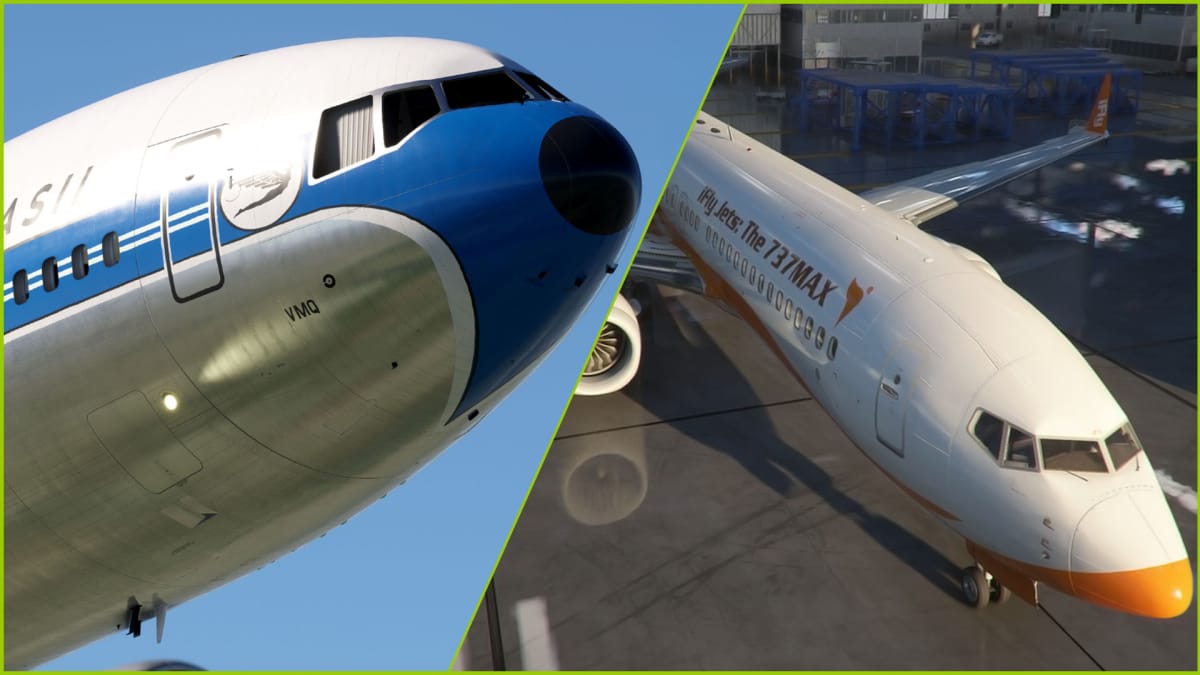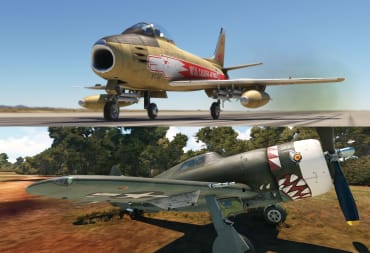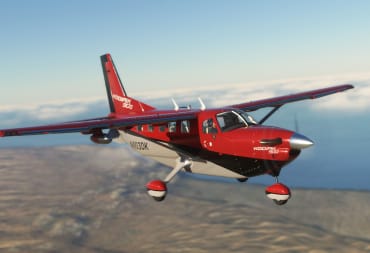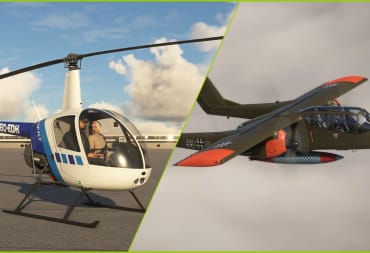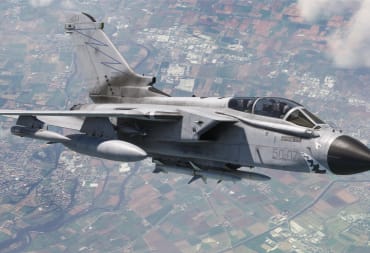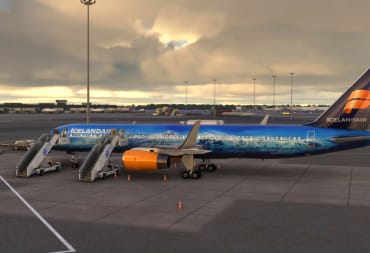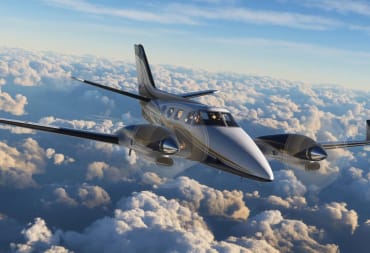Third-party developers released new screenshots and details of relevant upcoming Aircraft for Microsoft Flight Simulator, while several scenery add-ons have been released.
We start with a new look at the Boeing 737 MAX in development at iFly.
For now, we get to see it the aircraft in the hangar, providing a good look at the work-in-progress external model. We hear from the developer that interior modeling is going well and testing of some of the systems has started.
Next, we move on to a much older but no less relevant aircraft. Aero Dynamics showcased its promising freeware McDonnell Douglas KC-10/DC-10 on its Discord server.
According to the developers, they have been focusing on three key areas:
- Exterior Detailing: We've meticulously recreated the intricate exterior of the aircraft, ensuring every rivet, panel, and antenna are faithfully represented, making the walk-around experience, one of a kind.
- Cockpit Customization: Delving into the pilot's domain, we've been working on accurately modeling different cockpit configurations for various variants of the aircraft. This includes options to pick from various gauges and systems for your flight.
- Backend Operations: Behind the scenes, we've been diligently building the core functionalities, establishing backend systems that govern the aircraft's various systems and ensuring each individual gauge functions realistically to the real-world counterpart.
Realistic rivet patterns have been added to the whole aircraft, alongside wear patterns that can be seen upon close inspection. Panels and doors have been faithfully reproduced, including interactive elements like the ground electrical power panel, wing refueling panels, pneumatic ground air panel, and ground AC panels.
Many details have been added to the flight deck, which is modular, letting players choose their preferred engine gauges, HSIs, VOR displays, DME displays, radios, ADF tuners, transponders, and more. The flight engineer station will also be customizable and fully functional.
Here's some more in-depth info directly from the developers.
For an example of systems interplay, let's discuss the APU and how that is interplayed with the pneumatic and electrical system. The below technical description has been represented faithfully in our jet: When the APU MASTER switch is moved to RUN, this sends power to the APU Inlet door relay which controls the opening of the APU Inlet door.
The door takes 20-25 seconds to open, and upon completion will close the contacts in another relay which then connects the power to the Electronic Control Board (ECB) which regulates various APU Operations.
When there is a momentary movement of the APU Master switch to the START position, this signals to the ECB to perform the startup procedure. There are multiple stages to the APU start, and multiple self checks by the ECB to ensure safe starting conditions. If any of these conditions are not met, then the APU will perform an auto-shutdown.
For instance, before commencing the startup procedure by powering the START RELAY DRIVER, the ECB will check whether the APU's current N2 is less than 50% and no existing shutdown signal is present.
Once the START RELAY is powered, a starter motor will drive the engine shaft to start pulling in air from outside. At the same time, power is supplied to the Start Period Timer. If 60 seconds should pass prior to the starter motor disengaging, the auto shutdown sequence will start, as this indicates suboptimal starting conditions, due to a high likelihood of unbalanced air to fuel ratio at that stage.
While the N2 picks up RPM, this generates electrical pulses which are converted to DC current and is used to electrically measure N2 rpm percentage. Once N2 reaches 6.5% N2, the ECB evaluates whether it is safe to start ignition.
This includes checking the current ambient temperature isn't above 815 degrees Celsius, which is detected by EGT thermocouples, no emergency shutdown signal, and N2 > 6.5% and < 95%. Given these conditions are satisfied, ignition begins and accelerates the N1 and N2 turbines.
There is a coupling of N1 and N2, which can be modeled a variety of ways, and we've chosen to model it with a good middleground between performance and complexity. This model accounts for some of the current atmospheric conditions, as air density has a huge effect on the N1 and N2, and have been tuned to approximate starts that faithfully represent the real jet, based on various references.
This means that every start will be slightly different, and sometimes could result in some interesting cases. For example, on a hot day, the air is less dense which can cause a slow start, which could trigger a shutdown sequence.
This is because it is likely that N1 does not reach 10% as N2 crosses 50%, which triggers an auto-shutdown by the ECB. Another possibility is that the max allowable EGT could be exceeded. This max EGT is dynamic based on the N2 speed. As N2 gets to 50%, and given that N1 is greater than 10%, more fuel is introduced and this will disconnect the starter motor, which will cause a spike in EGT, and effectively change the acceleration function of N1 and N2 due to more energy being introduced by the fuel.
This will trigger a rapid growth of N2 towards 100% and N1 towards 63% (unless you're above 7000 ft, in which case it's 89%). As the N1 and N2 values converge to their baseline values, the EGT will also converge to some stable temperature.
The APU N1 RPM adjusts based on aircraft needs based on the electrical and pneumatic system. At 63% N1, the APU can power the aircraft electrically, but is unable to do so pneumatically. Once the APU ISOL Valve (powered by electricity) is selected to the open position in the FE Panel, the APU N1 increases to 85% to supply the demanded air.
ISOL Valves for the #1-2 and #2-3 engines are automatically opened or closed as N1 crosses 74% RPM given that the switches are in the NORM position. For an engine start, this N1 will rise to 98-100% to supply the demanded air to perform an engine start. That is a small insight into how we're modelling the aircraft systems, and there will be much more to come!
Moving on to released scenery, we start with MK Studios, which released Josep Tarradellas Barcelona-El Prat Airport (LEBL) in Spain.
It's available on Orbx Direct, iniBuilds, Contrail, and Simmarket for approximately $14.61. It includes the following features.
- Lifelike recreation of Barcelona Airport LEBL including detailed terminal interior
- Working Nool VDGS devices including A-CDM
- Handcrafted 3D models of buildings, jetways, and airport facilities
- Custom, 30cm/pixel satellite image covering the airport
- Elevation data based on high quality LiDAR scan including runway and apron profiles
- Custom, up to date ground polygons with lines, dirts, markings and other details
- Realistic lighting for immersive day and night operations
- AI compatible
- AI parking codes
Next is Drzewiecki Design, which released its massive Warsaw package in Poland. At the moment, it's available on Simmarket for $23.74 but should be made available on the developer's other usual partners soon.
It includes the following:
- Dozens of detailed skyscrapers higher than 100m
- Numerous cultural & historic landmarks
- 12 bridges and several stadiums
- Obstacles such as chimneys and antennas
- 11 heliports including hospitals and private ones
- 15 custom-made airfields around the city, including EPBC Babice
Next, Spinoza released Nantucket Memorial Airport (KACK) in the United States. It's available on Simmarket for $21:30.
France VFR released Pau Pyrenees Airport (LFBP) in France, available on Simmarket for $10.88
Here's a list of features.
- High resolution ground textures reworked aerial images from IGN.
- Detailed ground markings.
- Photo-realistic 3D buildings specific.
- Vegetation reworked on the platform and its surroundings.
- Realistic night lighting reworked.
- Runways profiles (slopes) reworked.
- Compatible with our VFR FRANCE product range.
- Geo-referenced data for maximum compatibility with future add-ons installed on the same area.
- Development process 100% SDK (System Developement Kit) specifications compliant, ensuring maximum compatibility with new releases.
- SIA – VAC – IAC – APT – ARRDEP charts provided.
Taimodels released Manchester International Airport (EGCC) in the UK, available on Orbx Direct, iniBuilds, and Simmarket for approximately $21.04.
It includes the following perks.
- Hand made and detailed PBR ground markings and textures according to the most recent airport situation.
- Hand made, Realistic terminals, cargo buildings airport buildings using MSFS PBR materials.
- Realistic airport lighting.
- Taxiways, aprons.
- Optimized for performance to be used on most types of systems.
- Custom jetways
Barelli MSFS Addon released Foggia "Gino Lisa" Airport (LIBF) in Italy. It's available on Simmarket for $15.81.
PKSim released Melilla Airport (GEML) in the Spanish exclave in North Africa with the same name. It's available on Simmarket for $21.11, including the following features.
- Manually and custom placed runway and taxi lights
- Detailed models and terminal interior with PBR materials.
- GSX ready with boarding and debording waypoints and animated doors.
- Custom and realistic ferry routes to Motril and Almeria.
Lastly, Pogratz Pagel released Leros Municipal Airport (LGLE) in Greece. It's available on Simmarket with the perks listed below. It's priced at $15.15
- realistic recreation of Leros Municipal Airport
- PBR materials
- inlcudes Moor & Dock and Artemis shipyards in close proximity to the airport
- fishing farms and sailing ships in the bays visible on approach to runway 14
As usual, you can come back often and check out TechRaptor's daily Microsoft Flight Simulator news, which will help you navigate this complex third-party industry.
